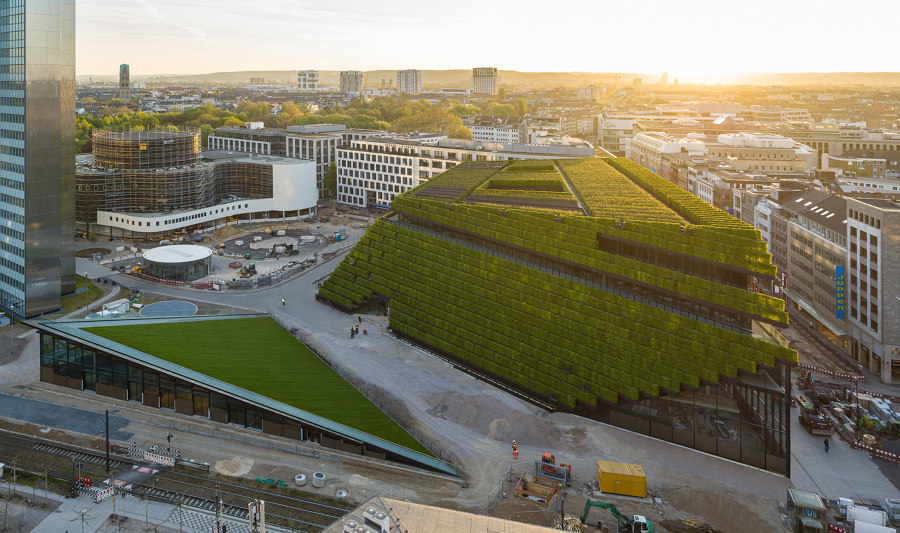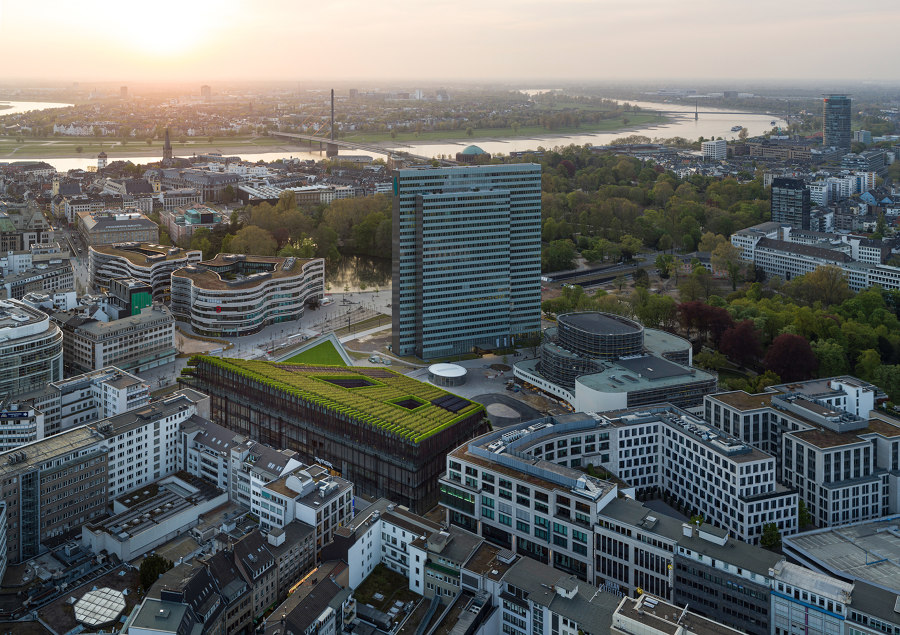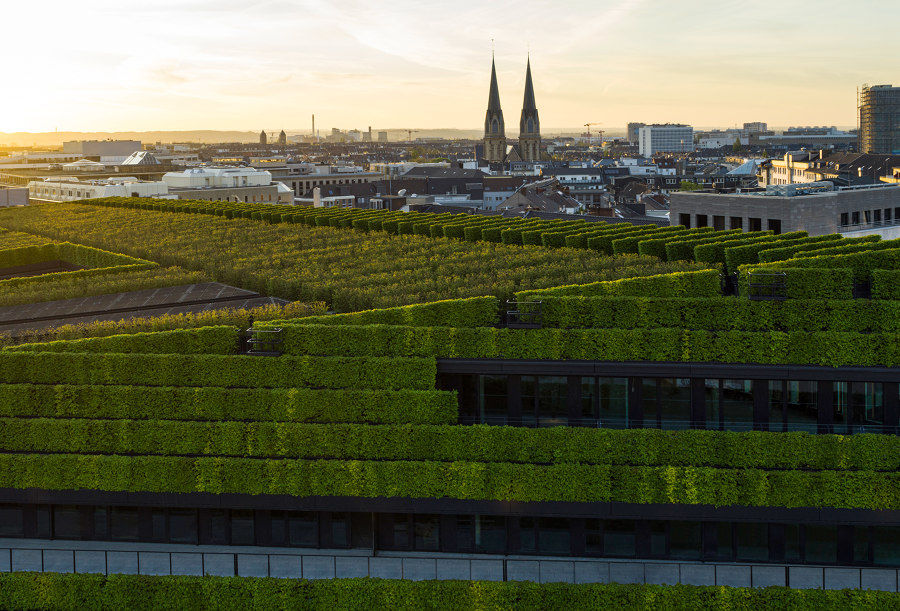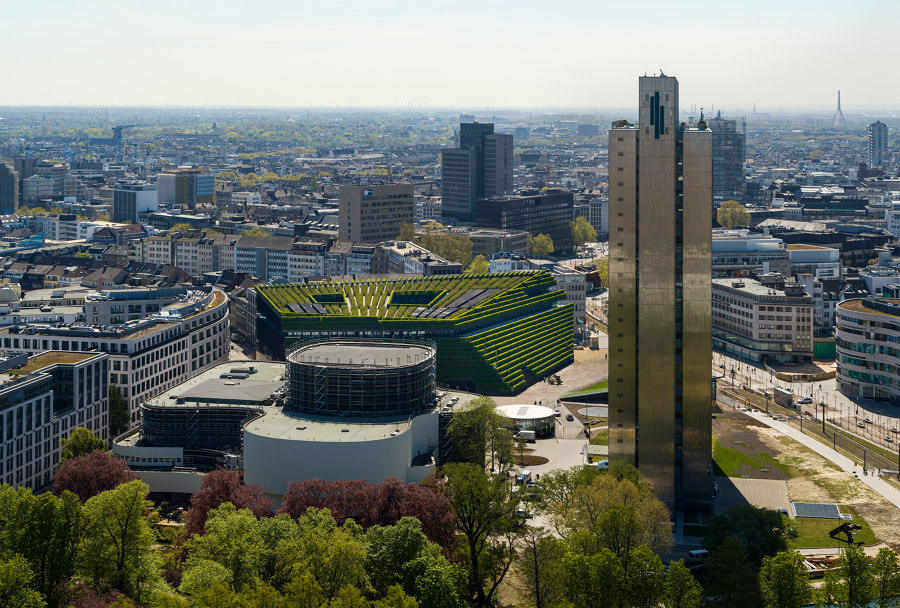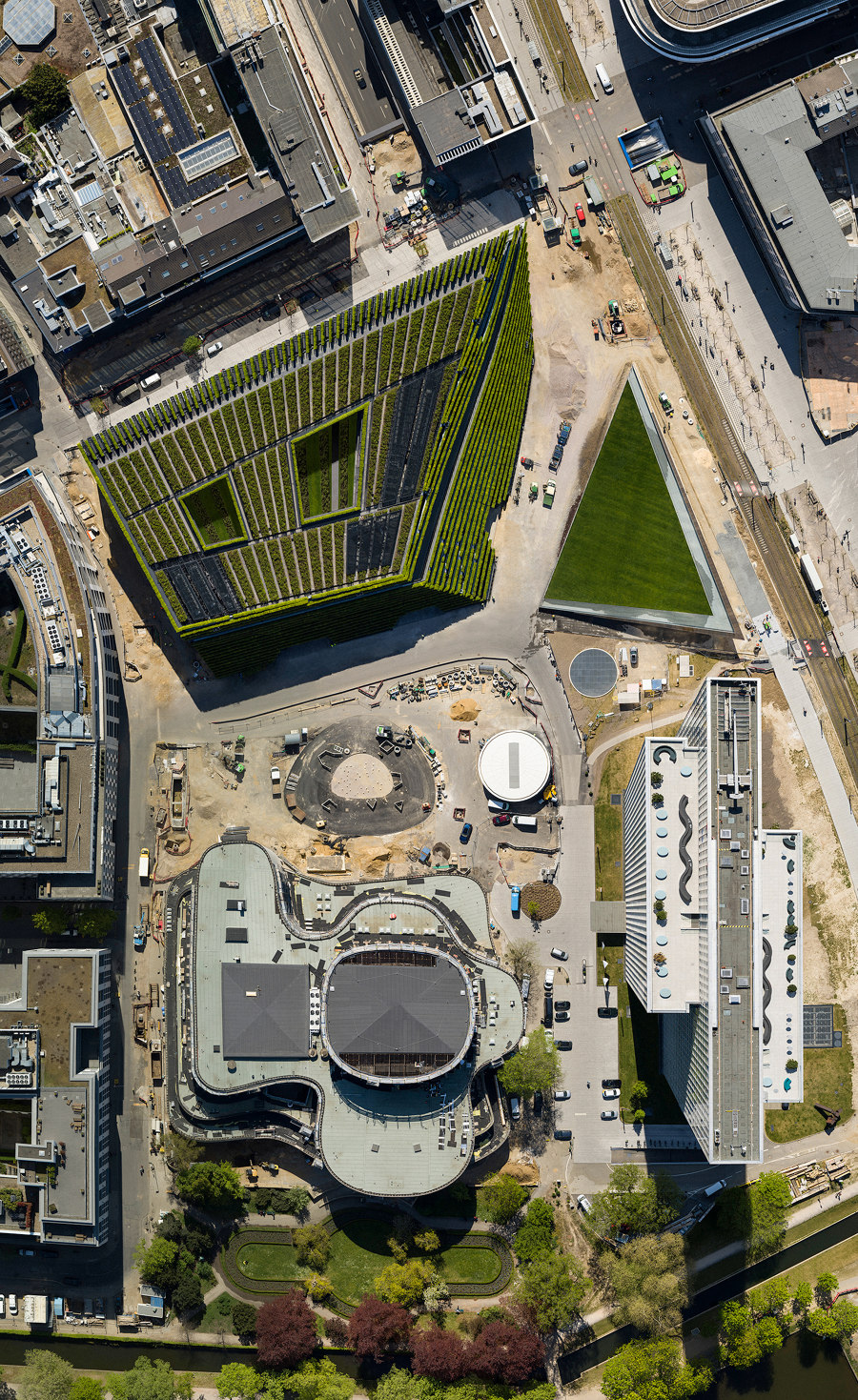8 kilometres of hornbeam hedges, over 30,000 plants – Europe’s biggest green facade is a key element of the Kö-Bogen II commercial and office building – and is now complete. The ensemble marks the conclusion of an extensive urban renewal project in the heart of Düsseldorf.
Kö-Bogen II also represents a paradigm shift: from an urban perspective, it signals a departure from the automotive era and a turn towards peopleoriented planning. And with Europe’s largest green facade, it offers a forward-thinking urban response to climate change. Giving back as much green as possible to the city is a task that ingenhoven architects have been working on for decades and across different climate zones. With its supergreen® concept, the office is taking a comprehensive approach to sustainability.
Today, at the site where an elevated motorway dominated the landscape until 2013, the Hofgarten has moved back into the heart of the city. The composition of Kö-Bogen’s dynamic green facades was inspired by Land Art. They enable the new building complex to oscillate in a deliberate indeterminacy between city and park, and open up the view to icons of post-war modernism – the clear austerity of the Dreischeibenhaus [1960] and the buoyant lightness of the Schauspielhaus [1970], whose renovation was also undertaken by ingenhoven architects. Kö-Bogen II is a contemporary answer to these two historic landmarks, confident without being overbearing. Since 1992, Christoph Ingenhoven has been pursuing the idea of redesigning this central part of Düsseldorf and has provided the city with numerous essential impulses through his work.
Between city and park – a new type of building
Kö-Bogen II, a two-part commercial and office building, was developed in response to the existing urban situation. With their sloping facades turned towards each other, the five-storey, trapezoidal main building, together with its smaller, triangular counterpart, form a dynamic entrance to Gustaf- Gründgens-Platz. Approaching the building from Schadowstrasse or Berliner Allee gives an unobstructed view of the icons of post-war modernism – the Dreischeibenhaus and the Schauspielhaus – and behind them the Hofgarten [the public garden] with its magnolia trees. The Kö-Bogen facades facing the plaza at Gustaf-Gründgens-Platz are entirely green, entering into a dialogue with the Hofgarten.
Functionally, Kö-Bogen II mediates between the different facets of urban life: between the pleasures of culture and of shopping. A variety of uses – retail, gastronomy, offices, and recreation – come together on a gross floor area of 42,000 square metres. Measuring 27 metres high and 120 metres long, the facade of the main building along Schadowstrasse – one of the busiest shopping streets in Germany – is completely glazed. Expanded metal slats structure the interior, varying in transparency from closed to open, depending on the perspective. The other facades including the roof are more tempered and planted with 8 kilometres of hornbeam hedges – Europe’s largest green facade. The accessible sloping roof of the 10-metre-high building opposite is also completely green and invites visitors to relax and take in the sun. The composition of these green areas is inspired by Land Art, and enable Kö-Bogen II to oscillate in a deliberate indeterminacy between city and park.
Eight kilometres of hornbeam hedges
The hornbeam was chosen as a native hardwood, and the selected varieties keep their leaves in winter. In spring the hedges glisten with their fresh, light green foliage, which deepen to rich, dark green in summer, then to golden brown in autumn. This greenery improves the city’s microclimate – it protects against the sun’s rays in summer and reduces urban heat, binds carbon dioxide, stores moisture, absorbs noise, and supports biodiversity. The ecological benefit of the hornbeam hedges equals that of approximately 80 fully grown deciduous trees. Giving back as much green as possible to the city is a task that ingenhoven architects have been working on for decades and across different climate zones. With its supergreen® concept the office is taking a comprehensive approach to sustainability. A bespoke planting concept is developed for each project according to the local context and marks a forward-thinking urban response to climate change.
For the project in Düsseldorf a detailed phytotechnological plan was developed in collaboration with the botanist Prof. Dr. Strauch from Beuth University of Applied Sciences in Berlin, and tested in a trial installation. Based on a precise site analysis, structural requirements were defined, such as the size and type of planters needed for the 1.3-metre-high hedges. A concept for the supply of water and nutrients along with plant maintenance, including regular pruning, was also developed. While the shrubs on the roof of Kö-Bogen II grow in conventional plant beds, those on the north- and west-facing facades are grown in a special system of horizontally arranged containers on a separate supporting structure that is firmly connected to the facade. The plants were supplied by a nursery where they had been growing since 2016, so they could be delivered to the construction site in autumn 2019 with fully developed roots.
Impulses for urban development since 1992
Christoph Ingenhoven has been pursuing the idea of redesigning the centre of Düsseldorf since 1992. With studies, urban planning concepts, and concrete projects, he has provided essential impulses for the evolution of a city that was long oriented towards cars and the unimpeded flow of traffic. In 2003 at the MIPIM, for example, he presented a design for comprehensive redevelopment in the area around Königsallee, Jan-Wellem- Platz, Hofgarten, and Gustaf-Gründgens-Platz, including the transfer of traffic into tunnels and the demolition of the elevated highway. In 2014, ingenhoven architects won the limited international competition for Kö-Bogen II. From 2018 to 2020, the office refurbished the Düsseldorfer Schauspielhaus. The approach was sensitive and understated, while undertaking a clear internal restructuring of the building towards Gustaf- Gründgens-Platz.
Today, at the site where an elevated motorway dominated the landscape until 2013 – in the spirit of the garden architect Heinrich Hillebrecht – the Hofgarten has moved back into the heart of the city through a more people-oriented approach to urban planning. In Düsseldorf’s new city centre, three different architectural positions converge to shape the urban fabric: the clear austerity of the Dreischeibenhaus by Helmut Hentrich and Hubert Petschnigg [1960], the buoyant lightness of the Schauspielhaus by Bernhard Pfau [1970], and the entirely green, dynamic facades of Kö-Bogen II by ingenhoven architects [2020]. Each representative of its time, none in competition with the others.
Design Team:
ingenhoven architects: Christoph Ingenhoven, Peter Jan van Ouwerkerk, Cem Uzman, Mehmet Congara, Ben Dieckmann, Patrick Esser, Vanessa Garcia Carnicero, Yulia Grantovskikh, Tomoko Goi, Olga Hartmann, Jakob Hense, Melike Islek, Fabrice-Noel Köhler, Christian Monning, Daniel Pehl, Andres Pena Gomez, Peter Pistorius, Lukas Reichel, Jürgen Schreyer, Susana Somoza Parada, Jonas Unger, Nicolas Witsch, Dariusz Szczygielski, Stefan Boenicke, Thanh Dang
Project management: AIP Bauregie GmbH, Düsseldorf
Structural planning: Schüßler- Plan Ingenieurgesellschaft mbH, Düsseldorf
Development plan: Heinz Jahnen Pflüger – Stadtplaner und Architekten Partnerschaft, Aachen
Geotechnical consulting: ICG Düsseldorf GmbH & Co. KG
Facade planning – green facades and green roofs ingenhoven architects
Phytotechnology – building greenery: Prof. Dr. Strauch, Beuth University of Applied Sciences, Berlin, Department of Life Sciences and Technology
Consultation on vegetation ecology: Prof. Dr. Reif, Albert Ludwigs University Freiburg, Chair of Site Classification and Vegetation Science


